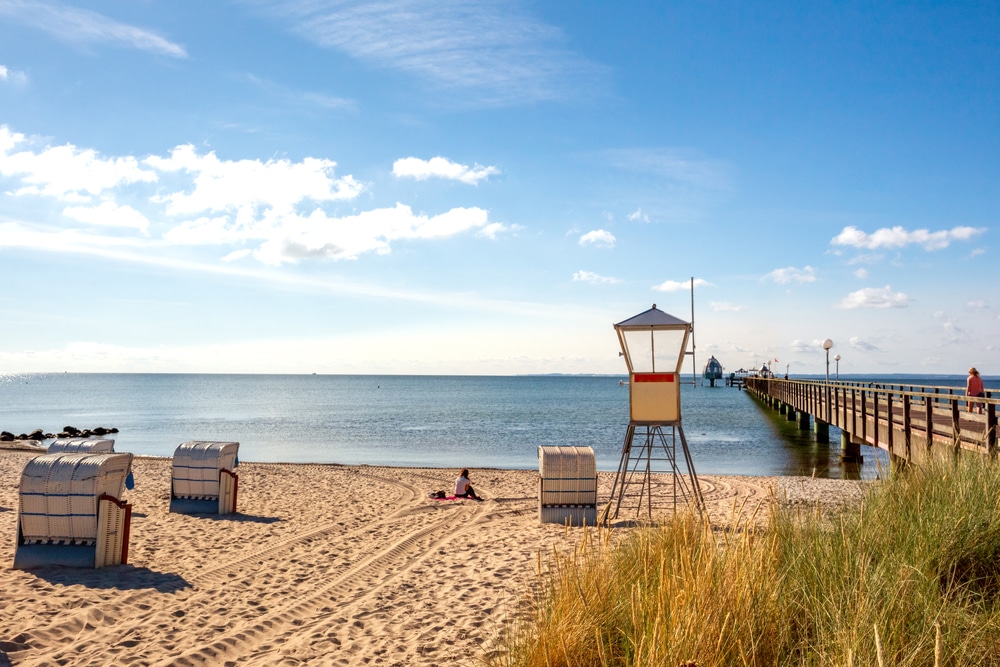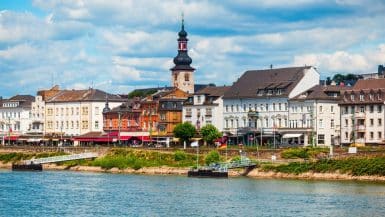The community of Grömitz in the sunny southeast of the district of Ostholstein, which has been known and popular as a hospitable bathing and holiday resort for decades, is a traditional seaside resort in the heart of the Bay of Lübeck. The most important crowd puller is the more than 8-kilometre-long south beach with first-class tourist infrastructure, numerous hotels, holiday homes and apartment complexes in the centre. Just a little further out is the truly paradisiacal “Lensterstrand” with several campsites in the midst of romantic dune landscapes and idyllic bird sanctuaries.
One of the oldest seaside resorts on the German Baltic Sea is always worth a visit
When the then still quite sleepy and tranquil fishing village was named one of the first seaside resorts on the German and Holstein Baltic Sea coasts as early as 1813, the place already looked back on a history of permanent settlement spanning more than 600 years. Initially, members of West Slavic tribes probably built here from the 9. or 10th century, a fortified village called “Groebeniz” was fortified by a massive rampart, the remains of which are now partly in the Wall Museum in Oldenburg in Holstein. The oldest surviving building on site, on the other hand, is the Evangelical-Lutheran Nicolaikirche in Kirchenstraße, built around 1200 from field stones, which burned down completely during the Thirty Years’ War and lost its pointed tower. Between the early 14th and late In the 15th century, the development of the village was quite slow and leisurely. In 1323, the knightly family of the von Westensee near Kiel sold their property to the Benedictine abbey of Cismar.
In the historic monastery at the gates of the city, everything revolves around art today

Founded in 1245 and secularized in 1561 in the course of the Reformation in Holstein, the monastery in today’s Grömitz district of Cismar with currently about 800 inhabitants was a much-visited place of pilgrimage until then. Since 1987, the extensive building complex in the north of Grömitz has housed a branch of the Schleswig-Holstein State Museums. In winter, well-attended classical concerts are regularly held here. Up to 80,000 visitors also attend the nationally known large monastery festival including an arts and crafts market every year in mid-August. At the approximately 150 market stalls, food and drinks are offered in addition to clothing, jewellery and gift items. The grounds of the former monastery and its church can be visited in the summer months on Wednesdays and Saturdays at 5:00 p.m. as part of a one-hour guided tour. Guided visits for larger groups outside these hours are possible by prior registration and arrangement. A visit can be best combined with hikes on the approximately 5-kilometre-long hiking trail to the nearby Baltic Sea.
Where maritime trade with Scandinavia once flourished, pleasure boats now stop
From the 14th and 17th centuries, the natural local deep-sea harbour was at least as important for the economic development of the town of Grömitz as the Cismar Monastery, where numerous cargo ships from northern German Hanseatic cities and Denmark unloaded their precious goods and brought them ashore. However, after the port of Grömitz gradually silted up due to local sandbanks such as the “Walkyriegrund”, which is still known as a profitable fishing ground for pike, trout and cod, long-distance and maritime trade quickly lost its economic importance again. Towards the end of the 1960s, the derelict harbour area was expanded into a sports boat harbour with initially 500 berths and, after an expansion between 1990 and 1992, with 780 berths. The modern marina on the maritime-themed adventure promenade also offers various cosy gastronomic facilities, a barbecue area, a catamaran and surf school as well as the best view of the blue sea off the coast, where regattas with international participation are often held seasonally.
High waves, long ships and many not too wild animals in the middle of East Holstein

Other popular and recommended excursion destinations in and around Grömitz are the almost 400-metre-long pier with diving bell, the “Grömitzer Welle” adventure pool and the 27-hole golf course, where you can improve your handicap with a sea view. The port is also home to the Grömitz sea rescue station, founded in 1912, where the 28-metre-long sea rescue cruiser “Felix Sand” has been ready for emergencies since 2021. Especially for families with children as well as animal lovers of all ages, the “Zoo Arche Noah Grömitz”, which opened in 1976 and now covers 10 hectares, offers many interesting impressions with currently about 300 animals from about 50 species. The seal enclosure and the petting enclosure with goats and donkeys are particularly popular with the youngest guests. The contemporary, spacious chimpanzee enclosure with an area of one hectare has been awarded in the past as extremely successful. In the dense and green forests around Grömitz there are two famous oaks that are often used as hiking destinations. The approximately 300-year-old oak at the Klostersee farm between Cismar, Grönwohldshorst and Kellenhusen and the 5-mark oak near Guttau, which is not far away and another 50 years older, are each protected natural monuments.
Whether on land or water: Grömitz and its surroundings enchant with a lot of nature
In the district of Cismar, which has already been mentioned and described in more detail above, there is the former monastery of the same name, as well as the natural history museum “House of Nature”, which opened in 1979, with thousands of fossils, minerals and especially numerous molluscs (molluscs) such as mussels and snails. In the outdoor area of the museum, which is recognized as pedagogically valuable, there is a monastery garden based on the medieval model with about 100 species of colorfully blooming and intensely fragrant culinary and medicinal herbs. Also in the immediate vicinity of the small village in the Fiekenhörn forest area is the megalithic megalithic megalithic tomb Cismar from the Neolithic Age, which is often visited by hikers and cyclists. The authentic neighbouring communities of Grömitz, such as Kabelhorst, Manhagen, Riepsdorf, Grube, Kellenhusen and Schashagen, are also ideal for walking. If, on the other hand, you are drawn to the open sea, an excursion to Fehmarn, Boltenhagen and Travemünde from the pier in Grömitz is just the thing.




